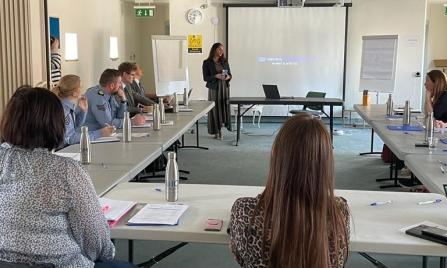-
Who we are
WHO WE AREThe International Organization for Migration (IOM) is part of the United Nations System as the leading inter-governmental organization promoting since 1951 humane and orderly migration for the benefit of all, with 175 member states and a presence in over 100 countries. IOM has had presence in Ireland since 2001.
About
About
IOM Global
IOM Global
-
Our Work
Our WorkAs the leading inter-governmental organization promoting since 1951 humane and orderly migration, IOM plays a key role to support the achievement of the 2030 Agenda through different areas of intervention that connect both humanitarian assistance and sustainable development.
- Data and Resources
- Take Action
- 2030 Agenda
IOM releases report on human trafficking between Northern Ireland and Ireland
In recent years, there has been growing discussion about the issue of human trafficking on the island of Ireland, with particular concern about movement between the Republic of Ireland and Northern Ireland. Despite this, there have been few studies or reports that seek to shed light on this issue, to better understand evidence, trends and responses to human trafficking on the island of Ireland. On the occasion of Anti-Slavery Day 2023, IOM UK together with IOM Ireland release the research report, “A Study on Human Trafficking between Ireland and Northern Ireland”, looking at human trafficking around the island of Ireland, including from Northern Ireland to Ireland (north to south), with a main focus on movements from the south to the north.
The research was carried out between November 2022 and May 2023, using primarily qualitative methods, drawing on in-depth, open-ended interviews with 23 key stakeholders from 18 organisations working directly or indirectly on the issue of human trafficking in Ireland and Northern Ireland. The interviews were complemented by IOM’s own analysis of the National Referral Mechanism (NRM) statistics for Ireland and Northern Ireland.
The report was presented in Belfast and Dublin, bringing together key stakeholders to discuss and disseminate the findings.
The main findings highlighted by key stakeholders include:
- In Ireland and Northern Ireland, as elsewhere, trafficking is much more prevalent than the data implies, remaining largely undetected with victims not being identified or referred for assistance. Official statistics do not provide an accurate picture of the extent of human trafficking on the island of Ireland.
- Potential victims enter Northern Ireland through the Common Travel Area from Ireland and are often detected through the asylum or immigration process. Organised crime groups take advantage of the “open” land border between the two jurisdictions to avoid detection and use business models that take advantage of the two jurisdictions, making human trafficking more difficult to identify.
- The number of formally identified victims that are reported as having been exploited in Northern Ireland and Ireland is very low, particularly of UK and Irish nationals.
- Forced criminality and child criminal exploitation are highly prevalent but less-known forms of human trafficking on the island of Ireland.
- Wider statutory services, civil society and the general public have a lack of understanding of the issue of human trafficking, including the indicators and potential vulnerabilities of which to be aware.
IOM’s three main recommendations included in the report are:
1) Closer collaboration and coordination between stakeholders in Ireland and Northern Ireland could help facilitate information-sharing, improve working relationships and enable more joined-up responses. This could be in the form of an All-Island Working Group on Human Trafficking.
2) Additional research is required to understand why victims may be exploited and vulnerable to trafficking, including studies that draw on the lived experience of survivors, particularly in relation to:
- Identification of Irish and UK national victims of human trafficking in Ireland and Northern Ireland
- Increasing trends of Eritrean and Somali nationals entering Ireland and travelling to Northern Ireland through the Common Travel Area
- Child criminal exploitation and child trafficking in Ireland and Northern Ireland.
3) The development of an all-island training programme on human trafficking for law enforcement authorities, statutory and non-statutory bodies could help improve awareness and capacity to combat trafficking. This could be complemented by strengthening data collection systems in both Ireland and Northern Ireland, aligning these where possible.
Click here to access the full report.
For more information, please contact Laura Jiménez, ljimenez@iom.int



